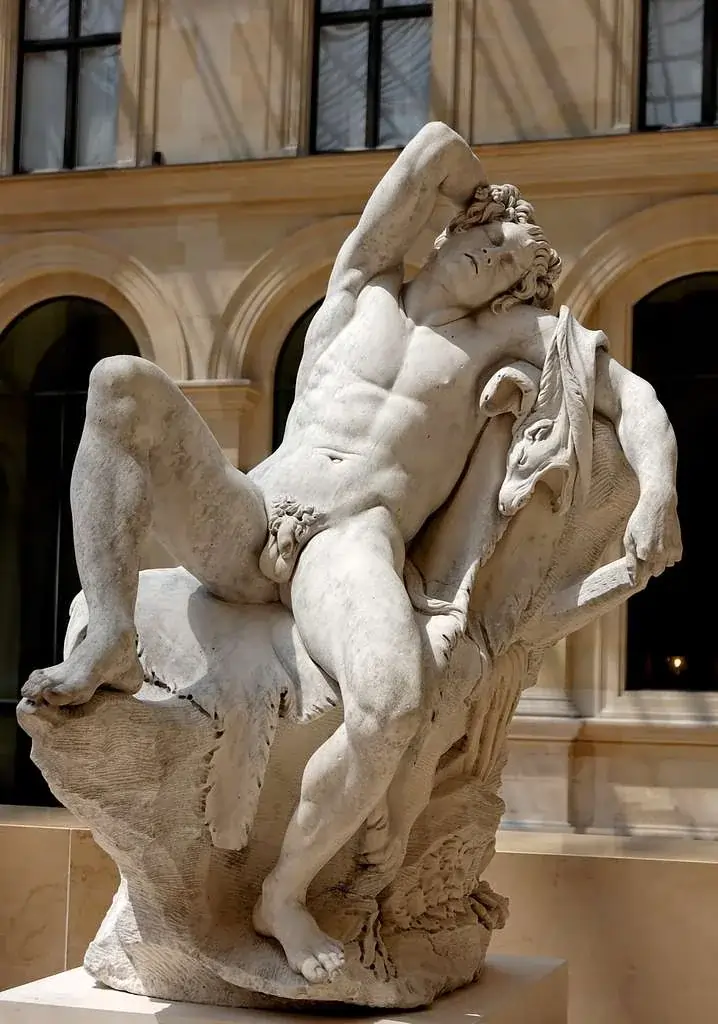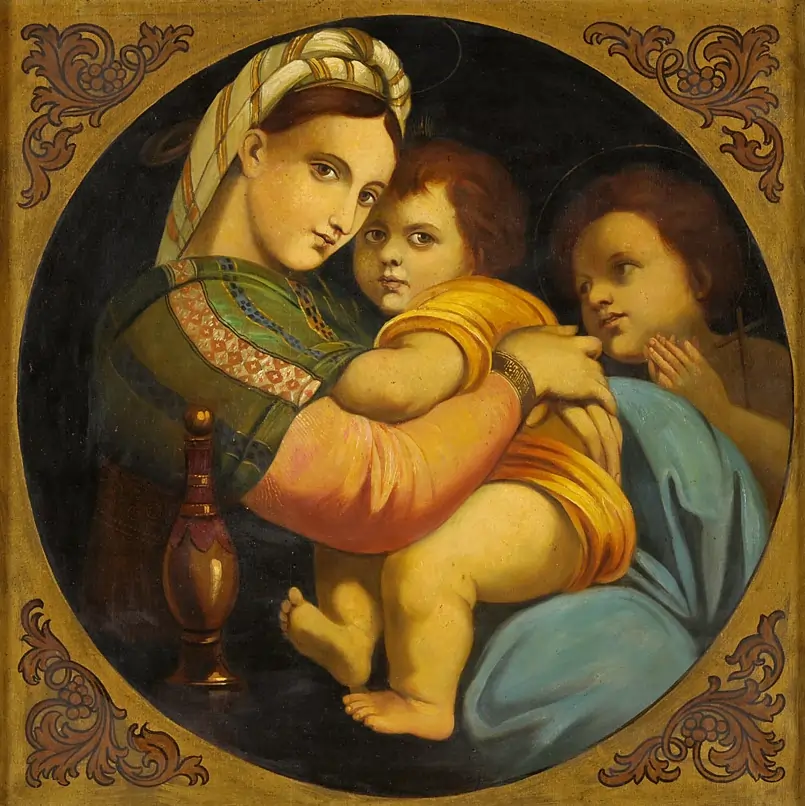The Barberini Faun is considered one of the instances of Hellenistic sculpture to have been unearthed so far. It’s a marble statue of life size that was located in Rome in the 17th century and portrays a sleeping satyr, with artistic intricacy and technical skill. This sculpture marks a juncture in Greek art by demonstrating the pinnacle of Hellenistic sculptural excellence.
Scholars and art lovers have been enchanted by this piece for centuries due, to its mix of classical myths and creative artistic style. The write up delves into the past of the Barberini Faun. From its unearthing beneath Castel Sant’Angelo to its residence at Munich’s Glyptothek museum. You’ll discover the sculptures attributes and its significance in the history of art as well as its enduring impact, on Western art traditions.
The Discovery and History of the Barberini Faun
The fascinating story of the Barberini Faun started back in the 1620s when laborers stumbled upon the marble statue in a trench encircling Castel Sant’Angelo in Rome.
Unearthing in 17th century Rome
The dig took place while enhancements were being made to the fortress; on orders from Pope Urban VIII in 1624.The sculpture was uncovered in the excavation near the site of Hadrian’s Maosoleum, where it was found partially finished. In records by Cassiano del Pozzo, from that era it was referred to as a sculpture resembling the famous Belvedere Torso statue.
Ownership by the Barberini family
The statue was first noted in records on June 6th of the year 1628 when it was acquired by Cardinal Francesco Barberini who was the nephew of Pope Urban VIII. While under the ownership of the Barberini family it was housed in the Palazzo Barberini for a span of, over 170 years. In 1799 their custodianship came to an end as they parted ways, with the statue selling it to sculptor and restorer Vincenzo Pacetti.
Acquisition by Prince Ludwig of Bavaria
The journey to Munich was filled with challenges and disagreements along the way as Pacetti tried to sell the masterpiece to buyers in England and France like Lucien Bonaparte while facing objections from the Barberini family who opposed the sale. The situation escalated into a competition made complex by an export restriction supported by influential figures such as antiquarian Carlo Fea and sculptor Antonio Canova. Crown Prince Ludwig of Bavaria managed to acquire the artwork with the help of his Martin von Wagner despite facing strong resistance from, within the art community.
It was clear that Ludwig was deeply passionate, about the sculpture from the way he meticulously planned ahead for it. Prior to completing the transaction for the purchase of the artwork he enlisted architect Leo von Klenze to create a chamber within the Glyptothek devoted exclusively to housing the Barberini Faun. By 1827 the allocated area had been prepared and in 1830 the museum officially opened as a showcase, for Ludwigs assortment of sculptures, which prominently featured this exceptional Hellenistic work of art.
Analyzing the Sculpture’s Unique Features
At a height of 2 meters and 15 centimeters tall stands the Barberini Faun sculpture which showcases the skill, in Hellenistic art with its meticulous focus, on anatomy and creative flair.
Monumental size and muscular physique
The statue showcases attention to detail in its structure. Especially notable, in the well-defined shoulders and chest area as well as the sculpted abdomen. The artist’s grasp of anatomy is evident in the depiction of tense abdominal muscles and prominent inner thighs along with the taut tendons on the upper chest. A slight tilt to the left, in the rib cage introduces a twist that enhances the figures complexity.
Provocative pose and facial expression
The sculpture depicts a scene of sleepiness, with intricate details and emotions woven into its design; a figure lying on rough terrain with its head arched back and cradled by a bent arm; the face showcases a delicate balance, between asymmetry accentuated by gravity’s pull on the features—the right cheek compressed while the left side expands; an open mouth and tousled hair add to the portrayal of a restless slumber filled with inner turmoil.
Blend of human and mythological elements
The Barberini Faun masterfully combines human and mythological characteristics. While the figure presents primarily as a powerful human form, subtle details reveal its supernatural nature:
| Mythological Features | Location |
| Pointed ears | Head |
| Small tail | Lower back |
| Ivy crown | Head |
| Nebride (panther skin) | Under figure |
The way the sculpture handles these aspects is quite subtle. Demands scrutiny to spot the mythological features that set this character apart as a satyr rather, than just a sleeping athlete. This skillful blend of mythological elements showcases the advancements of the Hellenistic era.
The Barberini Faun in Hellenistic Art Context
The Barberini Faun stands out as a change, from Greek sculpture styles and showcases the innovative artistic advancements of the Hellenistic era with its exceptional craftsmanship and influence, on ancient sculptural practices.
Departure from classical depictions of satyrs
In contrast, to the portrayals of satyrs seen in Classical artwork the Barberini Faun offers a perspective on these mythical figures.
While traditional images depicted satyrs as playful beings this sculpture stands out by presenting a representation of a lone and contemplative figure, at rest. The statues scale and human like features set it apart from earlier artistic interpretations.
Exploration of complex emotions and sexuality
The Hellenistic period witnessed a transformation in artistic expression, moving away from Classical reserve toward more complex emotional states. This evolution is evident in the following artistic elements:
| Classical Period | Hellenistic Innovation |
| Civic duty focus | Emphasis on love and romance |
| Reserved poses | Explicit eroticism |
| Idealized forms | Natural body representation |
| Active poses | Vulnerable positions |
Influence of Hellenistic artistic innovations
The sculpture showcases the style of the Pergamene School with its focus, on details and lifelike features. The realistic muscles and dynamic composition of the statue represent the era’s perspective on sculpting techniques. This shift away from balance and control highlights the Hellenistic era’s spirit, in pushing artistic boundaries.
The way the sculpture portrays sleep and intoxication reflects the eras fascination, with states illustrating how the Hellenistic artists skillfully conveyed intricate psychological states in marble through a blend of weariness and restlessness evident in the figures stance and face. Setting this period apart, from the simpler emotions depicted in Classical art.
Interpretations and Significance
The scholarly analyses of the Barberini Faun unveil depths of significance that mirror the cultural and artistic advancements during the Hellenistic era.
Mythological theories about the faun’s identity
There are interpretations that aim to elucidate the depiction of the sleeping satyr in this sculpture. One notable explanation links the artwork to the tale of King Midas. Proposes that it depicts the satyr ensnared by the renowned monarch. This hypothesis is supported by the physique of the figure and its individualistic presentation diverging from conventional satyr imagery. By situating this sculpture, within mythology it is placed in a cultural framework where satyrs symbolize the conflict, between civilization and primal instincts.
Representations of drunkenness and vulnerability
The statue marks a pivotal shift in the representation of mythological beings, particularly in its treatment of vulnerability and desire. This transformation is evident in the following aspects:
| Classical Period | Hellenistic Innovation |
| Satyrs as aggressors | Satyr as object of desire |
| Focus on social roles | Emphasis on personal experience |
| Limited emotional range | Complex psychological states |
| Defined gender roles | Fluid sexual dynamics |
The sculpture depicting a slumber delves into themes beyond mere physical unconsciousness by delving into the complex interplay of strength and vulnerability intertwined with desire, within Hellenistic society’s artistic expressions of that era.
Impact on later Renaissance and Baroque art
The Barberini Faun’s influence extends well beyond its original context, particularly affecting European art after its rediscovery. Its impact manifested in several key areas:
- Technical mastery in anatomical representation
- Innovation in depicting psychological complexity
- Integration of classical themes with contemporary artistic sensibilities
- Exploration of male beauty and vulnerability in sculpture
The statues intricate portrayal of shape and feeling set fresh standards, for depicting figures in artistry. The impact it had reverberates across generations of output symbolizing the lasting impact of creativity, in sculptural works.
Conclusion
The Barberini Faun is an example of the artistry seen in Hellenistic sculptures that beautifully combine technical prowess with profound emotional resonance. This extraordinary piece revolutionized the way mythological figures were depicted by showcasing a level of vulnerability and longing that was unprecedented, in its time. With its details and intricate portrayal of emotions the sculpture set a new benchmark for artistic brilliance in ancient sculpture by breaking away, from the traditional norms of Classical artistry.
The remarkable journey of the masterpiece, from being found in Rome to its location in Munichs Glyptothek reflects its influence on Western art history. It has had a lasting impact, beyond its setting by influencing evolution for centuries with its innovative portrayal of male beauty, emotional depth and mythological themes. The Barberini Faun stands as a symbol of creativity showcasing how ancient sculptors dared to push boundaries while showcasing exceptional skill that still captivates both viewers and creators today.
FAQs
What is the significance of the Barberini Faun statue?
The Barberini Faun is believed to represent more than just a typical faun; it might depict a mythical satyr who was deceitfully intoxicated and captured by King Midas, according to one theory. This statue, dating back to around 220 BCE, is housed in the Glyptothek in Munich, Germany.
Can you identify three features typical of Hellenistic sculpture?
Hellenistic sculptures are known for their departure from classical simplicity, featuring more dynamic compositions and emotional expressions. Key characteristics include the intricate spinal composition, elongated bodily forms, and the strategic placement within three-dimensional space.
Which work is considered one of the greatest masterpieces of Hellenistic sculpture for its visual impact?
The Great Temple of Zeus and Athena stands out as a significant masterpiece of the Hellenistic period, renowned for its exceptional artistic and visual qualities.
Where was the Barberini Faun originally discovered?
The Barberini Faun was unearthed in the 1620s in the moat of Castel Sant’Angelo in Rome, which was originally Hadrian’s Mausoleum. The discovery occurred during fortification works initiated by Barberini Pope Urban VIII in 1624.



